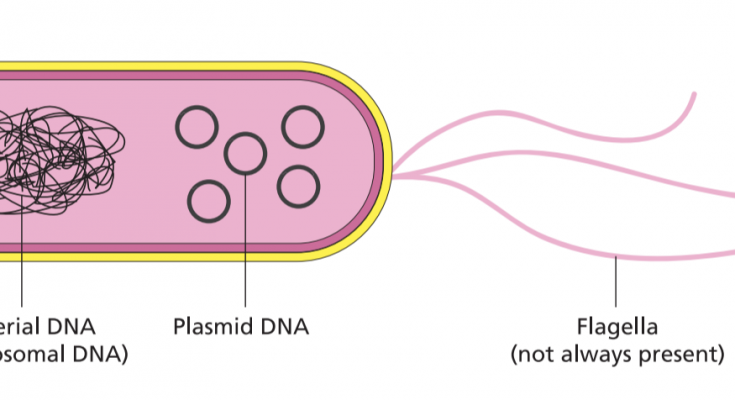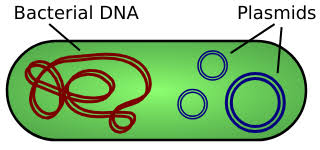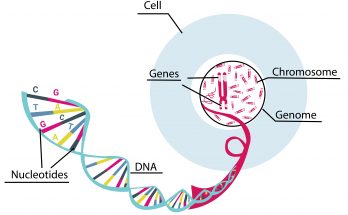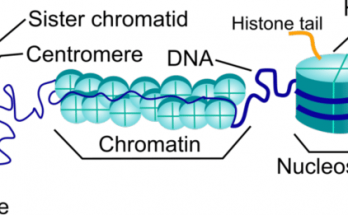Table of Contents
Plasmid DNA and Chromosomal DNA
Plasmid DNA-
Plasmid DNA is a type of DNA that exists outside the main chromosome in cells. It is commonly found in prokaryotes like bacteria. Plasmids are much smaller than chromosomal DNA and have a circular shape. They can replicate independently of the main genomic DNA. Plasmid DNA carries genes that are not crucial for the basic survival of the cell but can provide advantageous traits, such as resistance to antibiotics or the ability to fix nitrogen. Plasmids can be transferred between cells through a process known as horizontal gene transfer, which is different from the usual cell division.
Chromosomal DNA-
Chromosomal DNA, on the other hand, is the main genetic material found in both prokaryotic and eukaryotic cells. In prokaryotes, chromosomal DNA is typically circular, while in eukaryotes, it is linear and housed within the nucleus. This DNA is larger than plasmid DNA and contains the essential genes required for the growth, development, and reproduction of the organism. Chromosomal DNA replicates in coordination with the cell cycle, ensuring each new cell receives a complete copy of the genome. It is transferred from one generation to the next through cell division processes like mitosis or meiosis.
8 Key Differences Between Plasmid DNA and Chromosomal DNA in Table Format-
| # | Feature | Plasmid DNA | Chromosomal DNA |
| 1 | Type of DNA | Extrachromosomal DNA | Genomic DNA |
| 2 | Size and Shape | Smaller, circular | Larger; circular in prokaryotes, linear in eukaryotes |
| 3 | Occurrence | Found only in prokaryotes | Found in both prokaryotic and eukaryotic cells |
| 4 | Replication | Can replicate independently of the genome | Replicates with the genome |
| 5 | Function | Carries genes not essential for basic cell functioning, often related to antibiotic resistance or other special functions | Contains essential genes necessary for survival, growth, and reproduction |
| 6 | Transfer | Transferred by horizontal gene transfer | Transferred by cell division |
| 7 | Genetic Content | Lacks introns, primarily consists of genes with open reading frames | In eukaryotes, contains both exons and introns, which allow for complex gene regulation |
| 8 | Role in Genetics | Important in recombinant DNA technology due to its ability to be manipulated and transferred between organisms | Essential for storing and transmitting genetic information through generations |
| 9 | Number in Cells | The number of plasmids in a cell can vary widely, from one to several thousand depending on the type and condition of the cell | Typically, the number of chromosomes is constant for a given species and cell type |
Differences Between Plasmid DNA and Chromosomal DNA – Detailed Explanation-
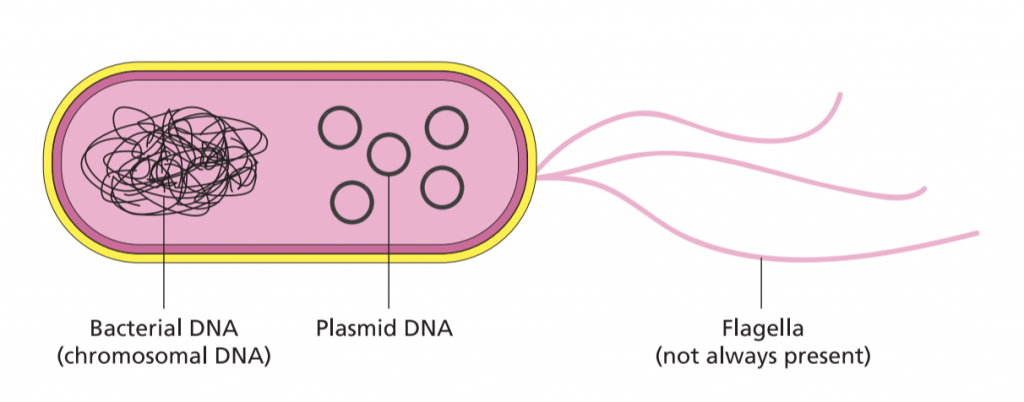
1. Differences Between Plasmid DNA and Chromosomal DNA in terms of Type of DNA and Occurrence
- Plasmid DNA- It is an extrachromosomal DNA molecule, separate from the chromosomal DNA. Plasmids are mostly found in prokaryotes like bacteria. They are not typically seen in eukaryotic cells except in some cases like yeast.
- Chromosomal DNA- This is the main genetic material of an organism, found in both prokaryotic and eukaryotic cells. In prokaryotes, it often forms a single, circular chromosome, while in eukaryotes, it comprises multiple linear chromosomes housed within the cell’s nucleus.
2. Differences Between Plasmid DNA and Chromosomal DNA in terms of Size and Shape
- Plasmid DNA- Plasmids are much smaller compared to chromosomal DNA. Their size allows them to be more flexible in replication and mobility. Being circular, they have a simple structure that facilitates easy transfer between cells.
- Chromosomal DNA- The size of chromosomal DNA is much larger, containing vast amounts of genetic information necessary for the organism. In prokaryotes, it is usually circular, while in eukaryotes, it is linear with complex structures like chromosomes that are composed of DNA wound around histone proteins.
3.Differences Between Plasmid DNA and Chromosomal DNA in terms of Replication
- Plasmid DNA- Plasmids can replicate independently of the host’s chromosomal DNA. This autonomous replication is crucial for their role in genetic engineering, as they can produce many copies of themselves and the genes they carry.
- Chromosomal DNA- Replication of chromosomal DNA is synchronised with the cell cycle. It ensures that each daughter cell receives an exact copy of the genome, a process that is tightly regulated by the cell.
Alos Check – Replication of plasmids in gram-negative bacteria.
4.Differences Between Plasmid DNA and Chromosomal DNA in terms of Function
- Plasmid DNA- Typically carries genes that may confer advantageous traits to the host organism, such as antibiotic resistance or the ability to metabolise unusual substances. However, these genes are not crucial for the basic functions of the cell.
- Chromosomal DNA- Contains genes essential for the survival, growth, and reproduction of the organism. It encodes the fundamental instructions for cellular functions and development.
Also Check – 5 Key Differences Between Gene and Genome
5. Differences Between Plasmid DNA and Chromosomal DNA in terms of Transfer
- Plasmid DNA- Can be transferred between cells through processes like conjugation (horizontal gene transfer), which involves direct cell-to-cell contact or through mechanisms like transformation and transduction. This capability is particularly important in the spread of antibiotic resistance among bacteria.
- Chromosomal DNA- Transferred to new cells via cell division (mitosis or meiosis). This transfer is a vertical process, from parent to offspring, ensuring genetic continuity.
Also Check – 5 Key Differences between Chromosome and Chromatin
6.Differences Between Plasmid DNA and Chromosomal DNA in terms of Genetic Content
- Plasmid DNA- Generally lacks introns; it mainly consists of genes with open reading frames that are ready for transcription and translation. This streamlined genetic structure makes plasmids efficient vectors for gene cloning and expression in biotechnology.
- Chromosomal DNA- In eukaryotes, contains a complex arrangement of exons (coding regions) and introns (non-coding regions). This complexity allows for the regulation of gene expression and the generation of multiple protein variants through processes like alternative splicing.
7.Differences Between Plasmid DNA and Chromosomal DNA in terms of Role in Genetics
- Plasmid DNA- Important tool in recombinant DNA technology due to its ability to replicate independently and carry foreign genes into host cells. It is used extensively in genetic engineering, biotechnology, and medicine.
- Chromosomal DNA- Essential for the storage of genetic information and its transmission through generations. It plays a critical role in the biological processes of development, differentiation, and metabolism.
Also Check – 4 Important Differences Between Genes and Chromosomes
Frequently Asked Question on Plasmid DNA and Chromosomal DNA
Multiple Choice Questions
- Which type of DNA is typically found only in prokaryotic cells?
- A) Chromosomal DNA
- B) Mitochondrial DNA
- C) Plasmid DNA
- D) Nuclear DNA
Answer- C) Plasmid DNA
- What is the shape of chromosomal DNA in eukaryotic cells?
- A) Circular
- B) Linear
- C) Triangular
- D) Hexagonal
Answer- B) Linear
- Which type of DNA can replicate independently of the main genome?
- A) Mitochondrial DNA
- B) Chromosomal DNA
- C) Plasmid DNA
- D) Both A and C
Answer- D) Both A and C
- Plasmid DNA is used in recombinant DNA technology because it-
- A) Contains many essential genes
- B) Is large and complex
- C) Can be easily transferred between organisms
- D) Is always linear
Also Check – 6 Important Differences Between DNA and Chromosomes
Answer- C) Can be easily transferred between organisms
- Which DNA type is not essential for basic cell survival but can confer additional capabilities such as antibiotic resistance?
- A) Mitochondrial DNA
- B) Chromosomal DNA
- C) Plasmid DNA
- D) Viral DNA
Answer- C) Plasmid DNA
- Chromosomal DNA in eukaryotes is found in which cellular structure?
- A) Cytoplasm
- B) Nucleus
- C) Mitochondria
- D) Endoplasmic reticulum
Answer- B) Nucleus
- What characteristic allows plasmid DNA to be particularly useful in genetic engineering?
- A) Ability to replicate independently of chromosomal DNA
- B) Large size
- C) Linear structure
- D) Presence of numerous introns
Answer- A) Ability to replicate independently of chromosomal DNA
- Which form of DNA transfer is characteristic of plasmid DNA but not chromosomal DNA?
- A) Vertical gene transfer
- B) Horizontal gene transfer
- C) Binary fission
- D) Transduction
Answer- B) Horizontal gene transfer
Also Check – 6 Key Differences Between DNA and Genes
True/False Questions
- Chromosomal DNA is found in both prokaryotic and eukaryotic cells.
- True
- False
Answer- True
- Plasmid DNA contains introns and exons.
- True
- False
Answer- False
- Chromosomal DNA replication occurs independently of the cell cycle.
- True
- False
Answer- False
- Plasmid DNA can replicate without the cell undergoing division.
- True
- False
Answer- True
- Chromosomal DNA in prokaryotes is typically linear.
- True
- False
Answer- False (It is typically circular)
- Both plasmid and chromosomal DNA can include genes that contribute to antibiotic resistance.
- True
- False
Answer- True
Short Answer Questions
- Explain why plasmid DNA is important in genetic engineering.
- Answer- Plasmid DNA is crucial in genetic engineering because it can independently replicate and carry foreign genes, making it an ideal vector for gene cloning and genetic modification of organisms.
- Describe how chromosomal DNA is transferred from one generation to the next.
- Answer- Chromosomal DNA is transferred to new cells through cell division, specifically through processes like mitosis in somatic cells and meiosis in germ cells, ensuring each new cell receives a complete and accurate copy of the genome.
- Why is plasmid DNA considered extrachromosomal?
- Answer- Plasmid DNA is considered extrachromosomal because it exists independently outside the main bacterial chromosome and has its own replication mechanism.
- How does the shape of chromosomal DNA differ between prokaryotes and eukaryotes?
- Answer- In prokaryotes, chromosomal DNA is circular, while in eukaryotes, it is linear and contained within the nucleus.
Long Answer Question
- Discuss the role of plasmid DNA in the spread of antibiotic resistance among bacterial populations.
- Answer- Plasmid DNA often carries genes that provide resistance to antibiotics. These plasmids can be transferred between bacteria via horizontal gene transfer processes such as conjugation, transformation, or transduction. This transfer allows even genetically unrelated bacteria to acquire and spread resistance traits rapidly, posing significant challenges in treating bacterial infections effectively.
- Explain the implications of horizontal gene transfer mediated by plasmid DNA in microbial resistance and biotechnology.
- Answer- Horizontal gene transfer via plasmids plays a crucial role in spreading traits like antibiotic resistance among bacterial populations, significantly impacting public health by making infections harder to treat. In biotechnology, this mechanism allows scientists to manipulate genes in a controlled environment, facilitating the development of genetically engineered organisms for various applications, such as producing pharmaceuticals, enhancing crop traits, or bioremediation.
